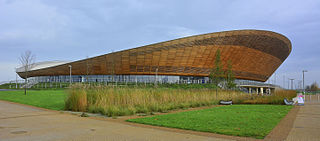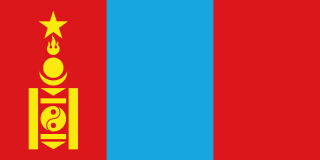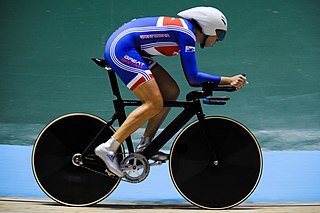Related Research Articles
Albionbaatar is an extinct mammal from the Lower Cretaceous Lulworth Formation of England. It was a member of the also extinct order Multituberculata and shared the world with the much larger dinosaurs. It is in the suborder "Plagiaulacida", family Albionbaataridae. The genus Albionbaatar was named by Kielan-Jaworowska Z. and Ensom P.C. in 1994 based on a single species.

Kryptobaatar, also known as Gobibaatar or Tugrigbaatar, is an extinct mammalian genus dating from the Upper Cretaceous Period and identified in Central Asia. This animal was a member of the extinct order of Multituberculata within the suborder Cimolodonta, and was a member of the family Djadochtatheriidae. It lived contemporaneously with some of the dinosaurs. Its skull had a length of perhaps 3 cm.

Sir Christopher Andrew Hoy is a former track cyclist and racing driver from Scotland who represented Great Britain at the Olympic and World Championships and Scotland at the Commonwealth Games.

Lee Valley VeloPark is a cycling centre in Queen Elizabeth Olympic Park in Stratford, London, England. It is owned and managed by Lee Valley Regional Park Authority, and it was opened to the public in March 2014. The facility was one of the permanent venues for the 2012 Olympic and Paralympic Games.

Dunc Gray Velodrome is a velodrome located at Bass Hill approximately five kilometres north west of the Sydney suburb of Bankstown. The cycling venue for the 2000 Summer Olympics, the Dunc Gray Velodrome was opened on 28 November 1999 with an opening ceremony which included performances by local talent Darren Sharp and other community groups. The Velodrome is named after Dunc Gray, the first Australian to win a cycling gold medal at the Olympic Games in Los Angeles in 1932.

Mongolia competed in the Summer Olympic Games for the first time at the 1964 Summer Olympics in Tokyo, Japan. 21 competitors, 17 men and 4 women, took part in 29 events in 5 sports.

Rebecca Jayne Romero, MBE is an English sportswoman, a former World Champion and Olympic Games silver medallist at rowing, and a former World champion and an Olympic champion track cyclist.

Edward Franklin Clancy is a British former professional track and road bicycle racer, who competed between 2004 and 2021.

The men's road race, a part of the cycling events at the 2008 Summer Olympics, took place on August 9 at the Urban Road Cycling Course in Beijing. It started at 11:00 China Standard Time (UTC+8), and was scheduled to last until 17:30 later that day. The 245.4-kilometre (152.5 mi) course ran north across the heart of the Beijing metropolitan area, passing such landmarks as the Temple of Heaven, the Great Hall of the People, Tiananmen Square and the Beijing National Stadium. After rolling over relatively flat terrain for 78.8 km (49.0 mi) north of the Beijing city center, the route entered a decisive circuit encompassing seven loops on a 23.8 km (14.8 mi) section up and down the Badaling Pass, including ramps as steep as a 10 percent gradient.

Steven James Burke is a former English track and road cyclist, who rode for the now disbanded Team Wiggins Le Col cycling team. He represented Britain at the 2008 Summer Olympics, beating his pre Olympics personal best in the individual pursuit by eleven seconds, to take the bronze medal. He stood on the podium alongside his cycling idol, gold medallist Bradley Wiggins.
Marc Ryan is a New Zealand racing cyclist.

The cycling competitions at the 2012 Olympic Games in London took place at five venues between 28 July and 12 August. The venues were the London Velopark for track cycling and BMX, and Hadleigh Farm, in Essex, for mountain biking. The road races took place over a course starting and ending in The Mall in central London and heading out into Surrey, while the time trials started and finished at Hampton Court Palace in Richmond upon Thames. Eighteen events were contested and around 500 athletes participated.

Dame Laura Rebecca Kenny, Lady Kenny, is a former British professional track and road cyclist who specialised in track endurance events, specifically the team pursuit, omnium, scratch race, elimination race and madison disciplines.

The cycling competitions of the 2016 Summer Olympics in Rio de Janeiro were held at four venues scheduled to host eighteen events between 6 August and 21 August.
The cycling competitions of the 2020 Summer Olympics in Tokyo featured 22 events in five disciplines. The 2020 Olympics were postponed to 2021 due to the COVID-19 pandemic.

Olivia Rose Podmore was a New Zealand professional racing cyclist. She represented her country at the 2016 Summer Olympics and the 2018 Commonwealth Games.

Ellesse Andrews is a New Zealand racing cyclist. She represented New Zealand at the 2018 Commonwealth Games and the 2020 Summer Olympics, where she gained a silver medal in the keirin. At the 2024 Summer Olympics, she earned two gold medals for winning the keirin and sprint, as well as a silver medal in the team sprint.
References
- ↑ "Yanjingiin Baatar Olympic Results". sports-reference.com. Archived from the original on 17 April 2020. Retrieved 19 August 2014.